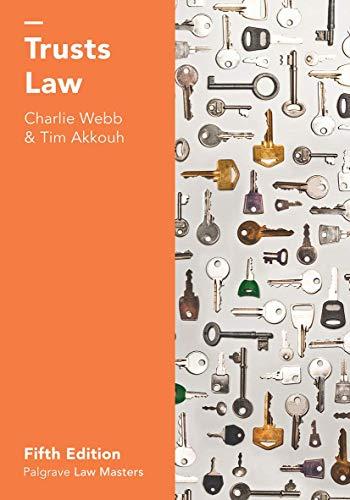Question
organize and make a journal from information below: The imposition of a ceiling on the length of time a criminal case should take to get
organize and make a journal from information below:
The imposition of a ceiling on the length of time a criminal case should take to get to trial is a complex and contentious issue that intersects with the right to be tried within a reasonable time, as guaranteed by the Charter of Rights and Freedoms (s. 11b) in Canada. The Supreme Court's decision in the Jordan case set a presumptive ceiling on trial delays, but this raises concerns about the impact on complex cases, the potential for a rush to judgment, and the repercussions for the repetition of crime. This journal will delve into these issues and explore whether the imposition of a ceiling on trial lengths is reasonable or not.
Right to be Tried within a Reasonable Time:
The Charter of Rights and Freedoms ensures that individuals charged with offenses have the right to be tried within a reasonable time. The concept of a reasonable time for trial is crucial to safeguarding the rights of the accused. In this context, the imposition of a ceiling on trial lengths aligns with this constitutional right and prevents indefinite delays that can infringe upon the defendant's rights (Blencoe v. British Columbia, 2000). This means that accused individuals do not languish in custody or under the threat of legal proceedings indefinitely, which is a fundamental aspect of a fair and just legal system.
1. Rush to Judgment:
One of the key concerns with imposing a ceiling on trial lengths is the potential for a rush to judgment. In an attempt to meet the prescribed deadlines, there may be pressure on the judiciary, defense, and prosecution to expedite proceedings, potentially compromising thequality of justice (Walker, 2019). The risk of erroneous convictions due to rushed proceedings is evident in numerous cases. For example, David Milgaard spent 23 years in prison for a crime he did not commit due to a rushed investigation and trial. This example serves as a stark reminder of the potential miscarriages of justice that may occur when the pursuit of expeditious trials takes precedence over thorough and meticulous legal processes.
2. Impact on Complex Cases:
Complex criminal cases, such as those involving multiple defendants or intricate legal issues, often require more time for thorough examination. A strict ceiling on trial lengths may undermine the ability to adequately address complex cases, leading to incomplete or unfair trials (R. v. Cody, 2017). The case of Robert Pickton, a notorious serial killer in Canada, involved complex evidence and numerous charges, making it a prime example of a case that necessitated an in-depth and meticulous legal process. The practical implications of imposing a rigid time limit in such cases are that it may compromise the pursuit of justice and the rights of both the accused and the victims.
3. Impact on Repetition of Crime:
Swift trials may deter individuals from engaging in criminal activities, as they face the prospect of swift justice. However, in cases with a ceiling on trial lengths, the rush to resolve cases may lead to wrongful acquittals, allowing guilty individuals to repeat offenses (Anderson & Heaton, 2012). For instance, if a violent offender is acquitted due to time constraints, they might commit further crimes, posing a significant risk to society. Striking a balance between timely justice and ensuring that dangerous individuals are not prematurely released is a paramount challenge in the criminal justice system.
4. Impact on Victims' Rights:
While the imposition of a ceiling on trial lengths protects defendants' rights, it can neglect the rights of victims. For example, in cases of sexual assault or homicides, victims and their families may endure prolonged emotional distress as they wait for closure, having the fear that delays may cause the accused to go free, which can have a lasting impact on their lives. Balancing the rights of defendants and victims is a challenge that legal systems must navigate.
Conclusion,
The imposition of a ceiling on the length of time a criminal case should take to get to trial is a complex issue that has both advantages and disadvantages. While it protects the defendant's right to a timely trial, it also presents challenges related to the rush to judgment, the handling of complex cases, and its impact on the repetition of crime. Striking a balance between the interests of all stakeholders in the justice system is essential for a fair and effective legal system.
References:
Blencoe v. British Columbia, [2000] 2 S.C.R. 307.
Walker, T. (2019). The "Jordan Era" of Criminal Justice: A Look at the Rigid Timelines Imposed by R. v. Jordan. Canadian Criminal Law Review, 23(1), 107-127.
R. v. Cody, [2017] 1 S.C.R. 659.
Anderson, D. M., & Heaton, P. (2012). Speed and public safety: How does a speedy trial affect the decision to drop charges? Journal of Legal Studies, 41(2), 319-347.
R. v. Jordan, [2016] 1 S.C.R. 631.
Sankoff, P., & Roach, K. (2018). The Jordan Decision: A Blueprint for Overhauling Delay in the Criminal Justice System. Alberta Law Review, 55(1), 155-173.
Step by Step Solution
There are 3 Steps involved in it
Step: 1

Get Instant Access to Expert-Tailored Solutions
See step-by-step solutions with expert insights and AI powered tools for academic success
Step: 2

Step: 3

Ace Your Homework with AI
Get the answers you need in no time with our AI-driven, step-by-step assistance
Get Started


